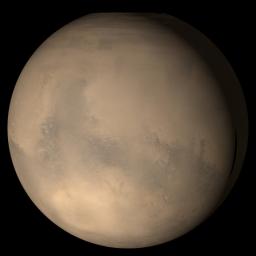Mars on 25 December 2003
Caption:
8 January 2004
This is how Mars appeared to the Mars Global Surveyor (MGS) Mars Orbiter Camera (MOC) wide angle system on 25 December 2003, the day that Beagle 2 and Mars Express reached the red planet. The large, dark region just left of center is Syrtis Major, a persistent low albedo terrain known to astronomers for nearly four centuries before the first spacecraft went to Mars. Immediately to the right (east) of Syrtis Major is the somewhat circular plain, Isidis Planitia. Beagle 2 arrived in Isidis Planitia only about 18 minutes before Mars Global Surveyor flew over the region and acquired a portion of this global view. Relative to other global images of Mars acquired by MGS over the past several martian years, the surface features were not as sharp and distinct on 25 December 2003 because of considerable haze kicked up by large dust storms in the western and southern hemispheres during th previous two weeks. The picture is a composite of several MGS MOC red and blue daily global images that have been map-projected and digitally wrapped to a sphere. Although the effect here is minor, inspection of this mosaic shows zones that appear smudged or blurry. The high dust opacity on 25 December impacted MOC's oblique viewing geometry toward the edges of each orbit's daily global mapping image, thus emphasizing the "blurry" zones between images acquired on successive orbits.
Cataloging Keywords:
| Name |
Value |
Additional Values |
| Target |
Mars |
|
| System |
|
|
| Target Type |
Planet |
|
| Mission |
Mars Global Surveyor (MGS) |
Mars Express, Mars Express (MEX) |
| Instrument Host |
Mars Global Surveyor |
Mars Express Lander |
| Host Type |
Orbiter |
Lander |
| Instrument |
Mars Orbiter Camera (MOC) |
|
| Detector |
|
|
| Extra Keywords |
Atmosphere, Color, Dust, Haze, Impact, Map, Storm |
| Acquisition Date |
|
| Release Date |
2004-01-08 |
| Date in Caption |
2003-12-25 |
2004-01-08 |
| Image Credit |
NASA/JPL/Malin Space Science Systems |
| Source |
photojournal.jpl.nasa.gov/catalog/PIA05125 |
| Identifier |
PIA05125 |

